- Blog
- Seasonality in Car Sales
Seasonality in Car Sales
Unlock the secrets of seasonal car sales trends in Europe. Learn how to optimize your business strategy, manage inventory, and maximize profits through strategic insights into automotive market shifts.

Car sales are not immune to the highs and lows of seasonal changes, with distinct patterns emerging throughout the year. Seasonality in car sales results from various factors, such as economic cycles throughout the year, tax season, and holiday periods. Specific car buying trends also play a big role, and different buyer profiles need to be considered.
Understanding automotive seasonality can help drive your business in the right direction and balance out the slower months throughout the year, and we are here to help give you a jump start and prepare for predictable market shifts.
So read on to find out some concrete steps you can take today to adapt to the inevitable automotive market shifts, learn a few smart car trader tricks to leverage those trends, and build long-term business resilience.
What do seasonal trends look like in the EU?
Car sales trends in Europe can be analyzed from a few perspectives. Market trends, in general, are impacted by inflation and a country’s economy as a whole, and automotive sales data show that the car industry is no different.
Some countries have specific tax periods or incentive windows that make certain months more attractive for new vehicle registrations, usually at the end of fiscal quarters.
Regional variations in auto market trends even reflect weather conditions, so convertibles and compact cars see higher demand in Mediterranean countries during summer. This regionality is sometimes influenced by a country-specific event that may occur in a certain market.
For example, Spain saw an increase in used-car transactions in the first half of 2024 as a result of leasing companies and rental companies renewing their fleets, with 1-3 year-old cars making up 33.9% of the market in the first two quarters, as reported by GANVAM. This is in line with the country’s plan to rejuvenate its aging car park.
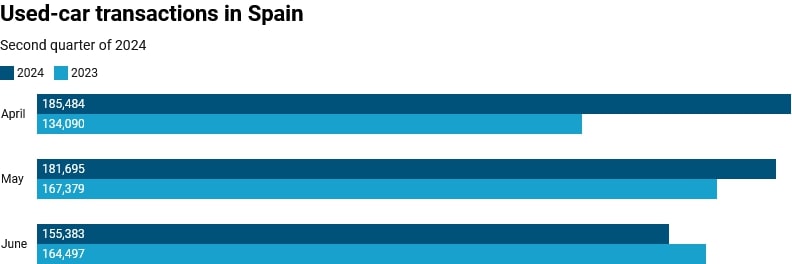
The Spanish used-car market was the fastest growing of Europe’s big five
early Easter holiday resulted in poor performance in March, a month which is usually characterized by solid sales of both used and new cars due to tax returns, nicer weather, and recovering from the winter slump.
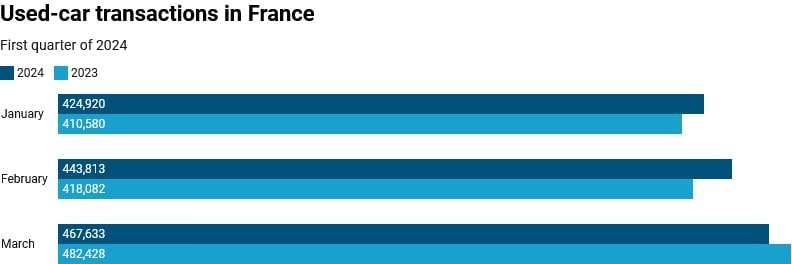
France saw a holiday-related drop in March 2024
France did bounce back in the third quarter, with over 4 million sales by the end of September, representing a 4.1% total growth compared to last year.
This just goes to show that regional trends are often unstable and influenced by a range of factors, but may be corrected during the year and provide a more stable annual average. That’s why it’s important to monitor dealership sales forecasting and consider various economic impacts on auto sales.
Key trends for used car sales
Used car buying trends usually depend on specific seasonal trends. Let’s look at the key trends that shape monthly car sales.
Seasonal depreciation patterns
In general, typical annual depreciation drops from 15-20% in the first year to 10-15% in subsequent years. For dealers selling directly to private customers, lifestyle factors play a big role in depreciation patterns. Luxury convertibles depreciate more rapidly at the end of summer, while 4x4 and SUV models see increased value retention during winter months.
B2B traders are driven more by strategic fleet renewal strategies and less influenced by seasonal lifestyle changes. There are, however, sector-specific trends – consider quick turnover of electric and hybrid vehicles in tech companies, or preference for robust, high-mileage vehicles in the logistics sector.
New model releases
New car launches create notable changes in the used car market. For example, when Mercedes-Benz releases a new E-Class, previous-generation models can see a 10-15% price drop. Popular brands like Volkswagen and BMW see predictable market shifts with annual model refreshes.
Buyer behaviors during different seasons
Each season of the year is characterized by certain stable and predictable trends when it comes to consumer behavior, especially if your main customers are private buyers or smaller companies, so it’s a good idea to include car demand by season in your sales strategy.
- Winter: Reliable, well-maintained vehicles with good winter performance
- Spring: Economic commuter cars after holiday spending
- Summer: Compact holiday cars
- Autumn: Practical family cars and fuel-efficient models
In addition to the middle of the summer, when sales are generally lower because of holidays, winter usually represents the slowest months for car sales. Used car buyers, and we are talking about private buyers here, are often people who can’t afford a new car and will usually save for Christmas gifts at the end of the year. This is also when traders will offer holiday promotions for cars, to encourage sales in the weaker months.
On the other hand, business customers will often do the opposite – use up remaining budgets by purchasing vehicles before the fiscal year closes so they pay less corporate tax. Rental agencies and dealerships might bulk-buy used cars to prepare for January, when private demand picks up.
Dealers might want to clear out older inventory at year-end to avoid carrying over unsold stock into the new fiscal year. Highlighting these opportunities to businesses could be an effective strategy.
Key trends for new car sales
Unlike used cars, new cars may see a spike at the end of the year when budget-conscious buyers are very unlikely to spend big. Why is that so?
New car buyers represent a different buyer profile. These are often wealthier people, who may consider buying a new car at the end of the year as a present for their family members, or simply to take advantage of the promotional sales events by dealerships. They are also willing to pay a premium price for the latest models, features, and personalization options.
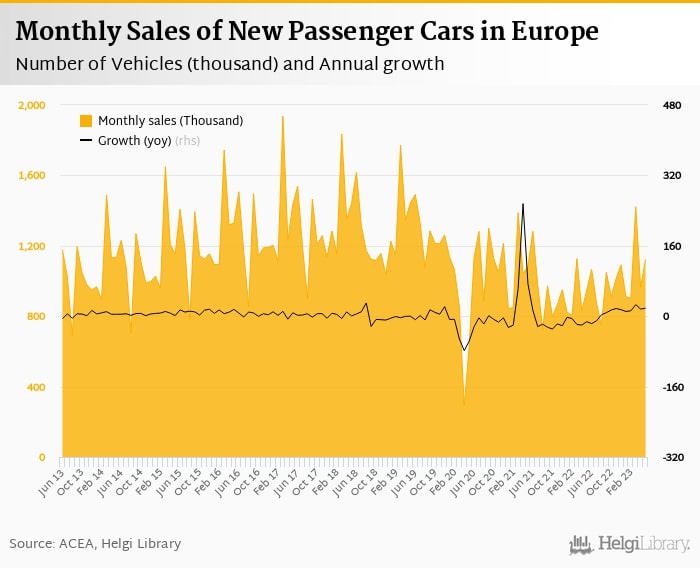
Source: ACEA, Helgi Library
What creates seasonality spikes in automotive sales?
As mentioned before, car demand changes by season, and you can use this information to adjust your offer and encourage buyers when the time is right.
The main things to consider are:
- End-of-year dealership promotions
- Tax considerations – tax return, new registration periods
- Bonus and salary cycle influences
- Holiday gift-giving and financial planning
- Seasonal lifestyle changes – summer road trips, winter preparedness
Best months for car sales
Just like in many other industries, March and April stand out as peak months for car sales, driven by tax refund season and improved weather conditions.
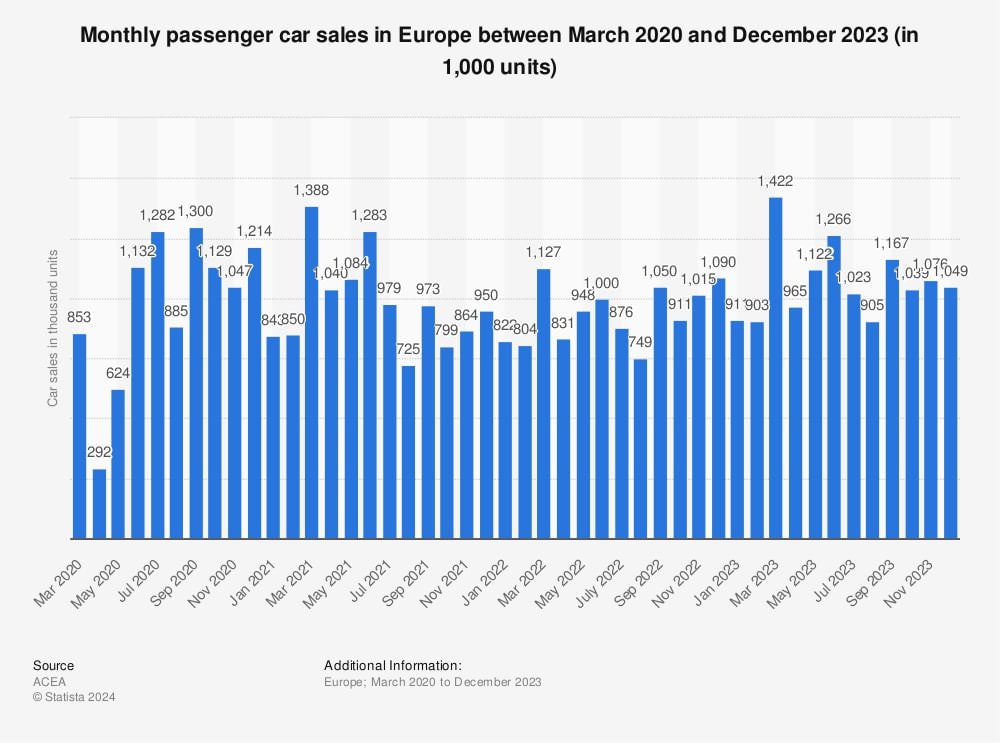
Source: Statista
To get the most benefit for your specific situation, depending on whether you are primarily a B2B trader or focus on B2C sales, here are some strategies you can use:
- Analyse historical data – identify months with consistent sales increases
- Leverage external factors – align sales promotions with tax refund season or fiscal-year-end trends
- Timing of promotions – schedule sales events around predictable spikes, like summer vacations or holiday gift-buying periods
How to leverage seasonality?
Understanding seasonality enables you to maximise sales during high-demand periods while managing costs in slower months.
Key strategies:
- Targeted marketing campaigns – use digital advertising to focus on specific customer demographics tied to seasonal trends
- Dynamic pricing strategies – adjust pricing to align with demand surges, offering competitive deals during peak periods and upselling during slower months
- Inventory management – stock vehicles that align with seasonal preferences, such as SUVs in winter and convertibles in summer
Slowest months for car sales
January and August are traditionally slower months for car sales due to consumer focus on holiday recovery or summer vacations – private buyers often delay purchasing decisions in January to benefit from post-holiday financial recovery.
Again, this depends on your target customers, as the situation is a bit different in B2B.
How to prepare your business for slower months?
Surviving slower months requires proactive planning and diversification of revenue streams. This means you should focus on after-sales services like maintenance, warranty extensions, and accessories.
Reduce inventory carrying costs by prioritizing high-demand models and use email and social media to nurture leads for future purchases.
You can also use the downtime to train your staff on new advanced sales techniques and digital tools.
Seasonal trends for EVs and hybrids in 2024
Despite government incentives and advancements in charging infrastructure, the EV and hybrid vehicles market has experienced some issues, but the future seems to be promising.
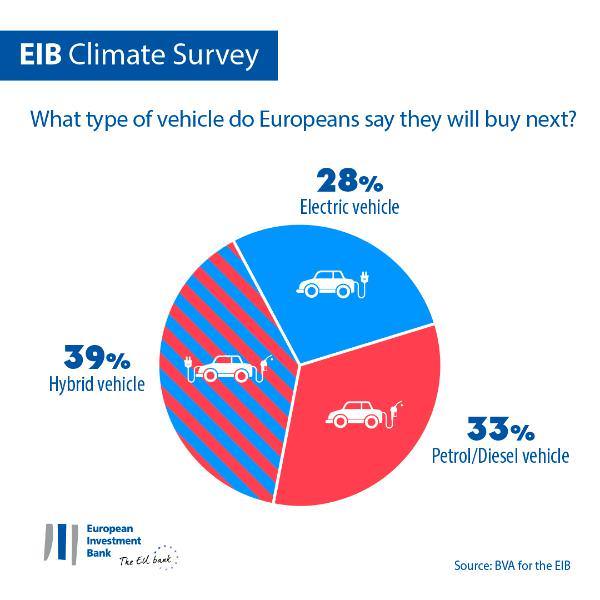
Two-thirds of Europeans will buy a hybrid or electric vehicle next
One key seasonal characteristic of these vehicles is range capacity, which is significantly reduced in winter due to battery performance in cold temperatures. On the other hand, summer can bring a similar problem, with high temperatures affecting charging efficiency.
Spring and autumn typically show the best performance, and these are also the months when car sales peak.
The corporate sector has seen lower numbers than expected, which can be explained by poor EV sales in Germany, France, Italy and Spain.
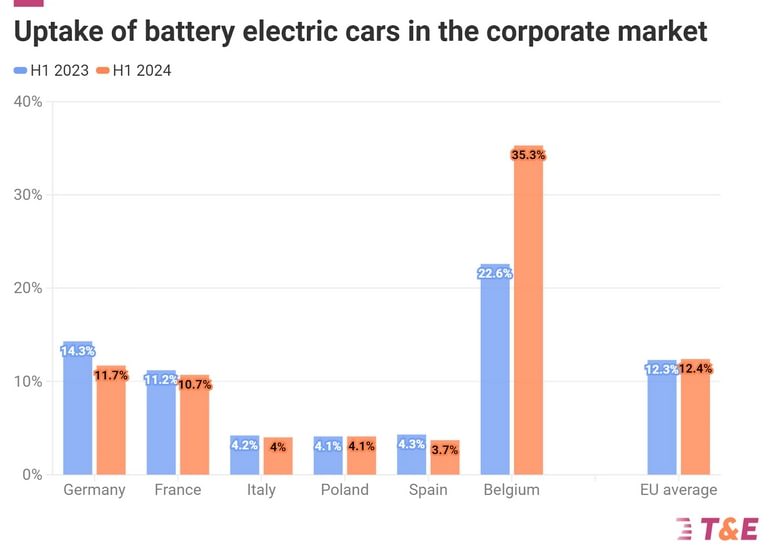
Source: T&E
Rely on your own data – predictive data analysis in a dealership
Internal sales data is a goldmine for forecasting and adapting to seasonal changes. It’s important to collect and learn from your own data, because your strategy needs to be adapted to your target buyers, the location you operate in, historical trends and anticipated sales patterns.
You can also browse our extensive offer of used cars for sale and get a deeper insight into trending vehicles – it may give you a good idea where to focus your inventory efforts for the coming year.
In 2024, the European used car market demonstrated some unique seasonal characteristics – Spain led growth among the major markets, while France showed resilience despite early-year challenges.
Seasonality in car sales is an opportunity to harness. By understanding the unique buying patterns throughout the year, leveraging targeted strategies and adapting to evolving market trends – especially in the growing EV and hybrid segment – you can maximise profits during peak periods and maintain resilience during slower months.
Success lies in staying informed, using predictive data analysis and continually refining your approach to meet both seasonal demands and long-term market shifts. Embracing seasonality as a strategic tool will position your dealership for sustained growth and a competitive edge in an ever-changing industry.
eCarsTrade's blog features curated lists and rankings of:
Browse our used cars
